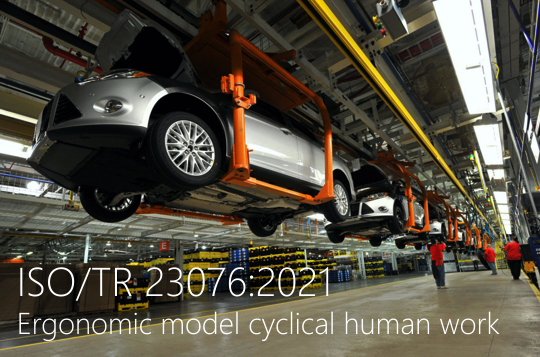ISO/TR 23076:2021 / Establishes an ergonomic model for cyclical industrial work
| Appunti Normazione | ||
| 16 Maggio 2025 | ||
| Salve Visitatore | ||
ISO/TR 23076:2021 / Establishes ergonomic model industrial work ID 14844 | 28.10.2021 / Preview in attachment This document establishes an ergonomic model for any cyclical human work planned and executed in an industrial competitive environment. It also covers the process of measuring work based on the concept of normal work performance and of the assessment of risk factors commonly associated with body postures, body or hand forces, manual material handling of loads and handling low loads at high frequency. ISO/TR 23076:2021 1. Scope This document applies to the adult working population and is intended to give reasonable protection for nearly all healthy adults. Those areas concerning health risks and control measures are mainly based on experimental studies regarding musculoskeletal loading, discomfort or pain and endurance or fatigue related to work organization and methods. The scope of this document is any cyclical human work planned and executed in an industrial competitive environment. The most typical cases are within industries where there is the need to define an expected output (products or services) based on the optimization of the trade-off between labour productivity and health and safety. The most sensitive organizations to this proposal are those within labour-intensive manufacturing industries with series and batch production systems: - automotive (original equipment manufacturer and tier 1 and 2 suppliers); Introduction 0.1 General The ISO 11228 series, ISO 11226 and ISO TR 12295 establish ergonomic recommendations for different manual handling tasks, repetitive movements and working postures. They apply to occupational and non-occupational activities and provide information for designers, employers, employees and others involved in work, job and product design, such as occupational health and safety professionals. This document can be used by industrial engineers for the application of ergonomic work allowances as a means to determine the correct quantity of cyclical work assigned to a worker in a manufacturing plant in order to meet the definition of a fair day’s work. A fair day’s work is that length of working day, and that intensity of actual work, which expends one day's full working power of the worker without encroaching upon his or her capacity for the same amount of work for the next and following days[26]. In the old-fashioned production systems (piecework-based) the fair day’s work concept was used in connection with the fair day’s wage. In this document, the studies about the definition of the fair day’s work become fundamental to connect work-study with the most recent knowledge about biomechanical load (occupational health and safety), with a special focus on the product-process design phase. Collegati |
||
|
|
||
 |
||
| www.certifico.com
è un sito di INVIO NEWSLETTTER Se vuoi cancellarti dall'invio della newsletter oppure effettua il login al sito ed entra nella Tua Area Riservata, in “Modifica dati” agisci con la spunta sul box di selezione “Newsletter”. L'Elenco completo di tutte le ns newsletter è qui: Archivio newsletter. |
||
  |
||
| Certifico Srl 2000-2025 | VAT IT02442650541 | ||


































